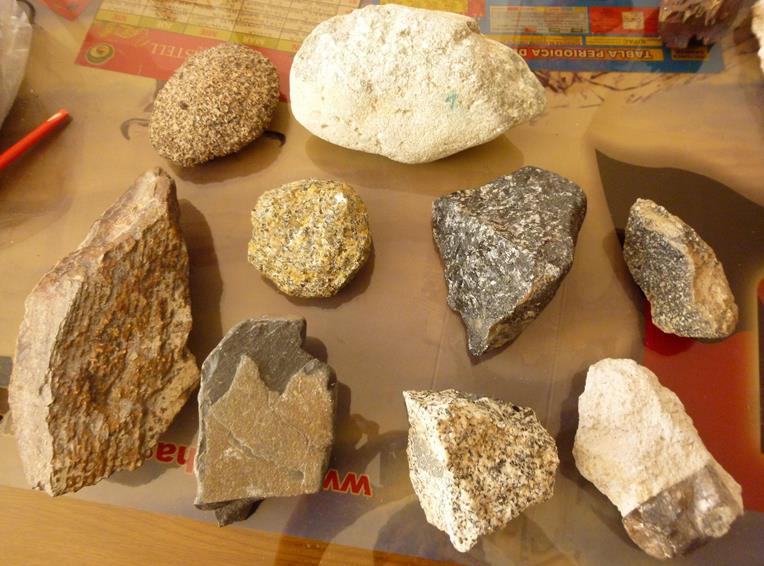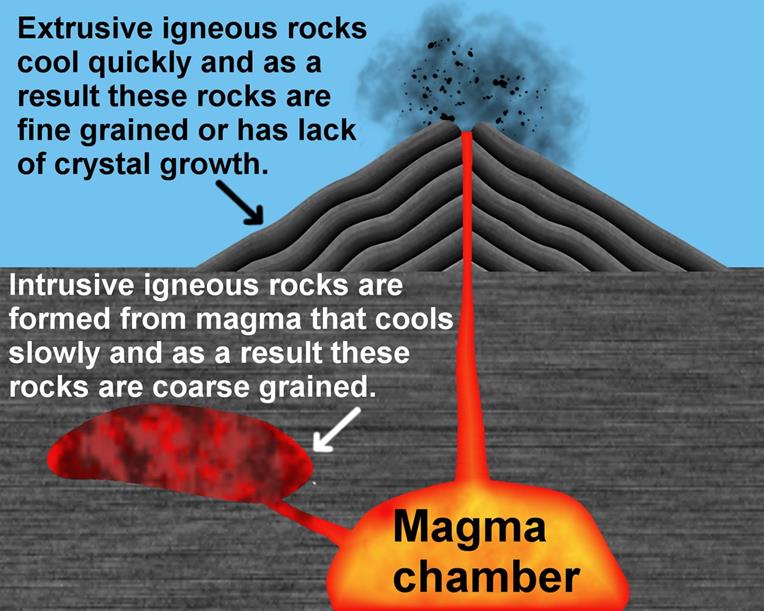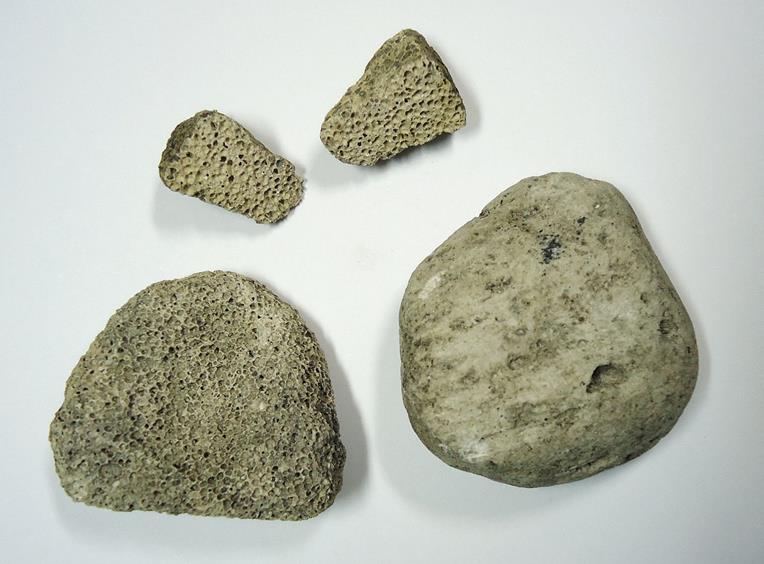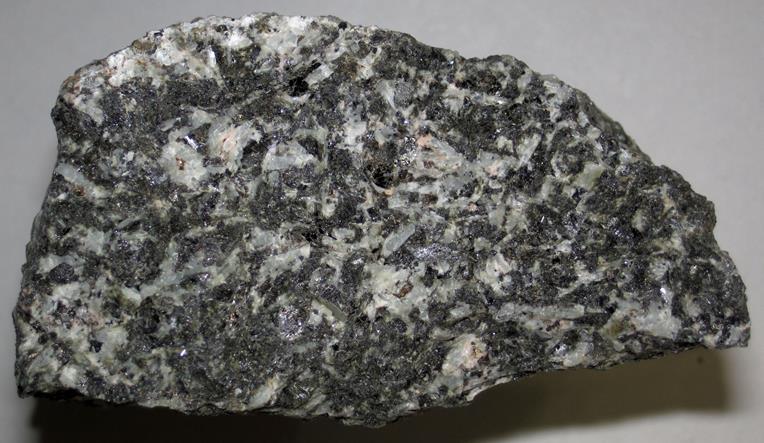Igneous rocks have many uses at home. Common ones include construction (aggregate, dimensional, or facing stone), making countertops, flooring tiles, landscaping, and paving. Also, they make statues, roads, or rail ballast, marking cemeteries, and some, like rhyolite, are ornamental stones.
How you will use igneous rock depends on the properties of the exact rock you have. It is time to look at what igneous rocks are? How are they formed, types, classification, and what are examples of igneous rocks and their uses?
Contents
- What are igneous rocks, and how are they formed?
- Types of igneous rocks?
- 1. Intrusive or plutonic igneous rocks
- 2. Extrusive volcanic igneous rocks
- How are igneous rocks classified?
- 1. Igneous rocks classification by texture
- 2. Igneous rock classification by chemical composition
- 20 Examples of igneous rocks and their uses
- 1. Granite
- 2. Basalt
- 3. Obsidian (volcanic glass)
- 4. Pumice
- 5. Tuff
- 6. Rhyolite
- 7. Diorite
- 8. Andesite
- 9. Gabbro
- 10. Scoria
- 11. Peridotite
- 12. Pegmatite
- 13. Kimberlite or blue ground
- 14. Syenite
- 15. Anorthosite
- 16. Dacite
- 17. Diabase, dolerite or microgabbro
- 18. Dunite or olivinite
- 19. Granodiorite
- 20. Komatiite
What are igneous rocks, and how are they formed?
Igneous rocks get their name from the Latin word ignis, which means fire, describing formation, i.e., from hot molten material. They are one of the main types of rocks and the Primary rock since they form from magma that starts the rock cycle. Others are sedimentary and metamorphic rocks.
Igneous rocks form when molten (magma or lava) rock cools and crystalizes or solidifies inside the Earth’s crust or on the Earth’s surface.
The molten (hot liquid or semi-liquid) rock is known as magma if trapped inside the Earth’s crust and lava if it makes its way to the Earth’s surface. It originates from the lower crust or upper mantle.
Magma melts at very high temperatures, i.e., 600 to 1,300 °C or 1,100 to 2,400 degrees Fahrenheit. This melting occurs at active plate boundaries and hot spots. Contrary to what many assume, the mantle has solid material.

Types of igneous rocks?
There are two main groups of igneous rocks. The first group is intrusive or plutonic, which forms when magma solidifies inside the Earth’s surface. The other is extrusive when lava solidification occurs near or on the Earth’s surface.

1. Intrusive or plutonic igneous rocks
Intrusive or plutonic igneous rocks form when magma cools and solidifies inside the Earth’s crust. These rocks are coarse-grained or have a phaneritic texture due to the slow cooling of the intrusions (intrusive rock bodies). Why? Because these intrusions get insulation from country rock and can take thousands to millions of years to cool and solidify.
Since they form inside the Earth’s crust, erosion and tectonic activities may expose these rocks to the surface. Examples of intrusive igneous rocks include diorite, gabbro, pegmatite, granite, diabase, and peridotite. And if you want to know some of the common intrusive rock bodies, they are stocks, batholiths, sills, dikes, and laccoliths.
2. Extrusive volcanic igneous rocks
Extrusive or volcanic igneous rocks form when lava (molten magma) cools and solidifies on or very close to the Earth’s surface. These rocks have fine or glassy textures because of the rapid cooling and solidification that doesn’t allow large crystals to form. Some volcanic rocks may have a bubbly or vesicular texture if the magma traps hot gas bubbles.
Extrusive igneous rocks form from a volcanic eruption or oozing fissures. Some activities that produce them are hotspots and divergent or convergent boundaries.
Examples of extrusive igneous rocks include andesite, basalt, obsidian, scoria, tuff, rhyolite, dacite, and pumice.
Note: Subvolcanic or hypabyssal
Besides the extrusive and intrusive, some igneous rocks are known as subvolcanic or hypabyssal. These refer to those formed at intermediate depths, especially in sills and dykes. Since cooling occurs relatively slowly, their grain size is medium.
How are igneous rocks classified?
There are two main ways in which geologists classify igneous rocks, i.e., by their texture and chemical composition. Let us look at each of these two ways.
1. Igneous rocks classification by texture
Texture in igneous rock refers to crystal sizes and mainly tells us more about the cooling rate. But may reveal other things such as the way of formation, e.g., via an eruption.
A slower cooling rate generally results in larger crystals while fast in smaller ones. However, the composition may also influence the crystal sizes.
| Texture | Description | Rock examples |
| Aphanitic | The aphanitic texture features fine-grains (not visible by the naked eye) rock. It forms by rapid lava cooling on or near the Earth’s surface, i.e., extrusive. To see the crystalline structure or grains, one needs a petrographic microscope to see them. | Basalt, rhyolite, and andesite |
| Phaneritic | The phaneritic texture has coarse grains with large crystals visible to a naked eye (unaided eye). These rocks form via slow cooling of magma that allows crystals to grow large and are usually intrusive igneous rocks. | Granite, gabbro, and diorite |
| Porphyritic | Porphyritic texture features large crystals <1mm or phenocrysts visible by a naked eye embedded in a fine-grained matrix or groundmass. These rocks can be intrusive or extrusive igneous and form from multi-stages cooling, i.e., slow then fast. A typical example is a slow magma cooling deep in the Earth’s crust followed by rapid cooling due to eruption or if it goes near the Earth’s surface. | Rhyolite porphyry andesite porphyry, |
| Pegmatitic | It is a very coarse-grained texture with large interlocking crystals, i.e., more than a centimeter (0.4 inches) and up to several meters or feet. Rocks with pegmatitic textures are intrusive igneous rocks. They form not from an extremely low cooling rate but from the final stage of magma, which is usually rich in dissolved water. This water allows some elements to diffuse fast to where crystallization is happening, hence forming larger crystals. | Pegmatite |
| Glassy or vitreous | It refers to the non-crystalline texture where very quick cooling (quenching) makes crystals fail to form, i.e., there is no time for crystallization. The resultant rock will have a non-crystalline, amorphous glass structure with few or no crystals. Glassy igneous rocks are usually extrusive and are sometimes known as volcanic glass. | Obsidian, pumice, pitchstone, and pumice, tachylite (tachylite) |
| Pyroclastic | Pyroclastic texture has a mixture of rock fragments, pumice (frothed magma), and volcanic ash. These extrusive or volcanic rocks form when an explosive eruption ejects lava, i.e., tephra, into the atmosphere. Tephra is (anything blasted into the air during a volcanic eruption with volcanic ash having particles less than 2mm, lapilli between2-64mm, and volcanic blocks or bombs). The tephra will then settle on the Earth’s surface, forming rocks. | Agglomerate, ash tuff, welded tuff, and lapilli tuff |
Besides the textures that refer to crystal size, here are additional igneous rock textures, descriptions, and rock examples.
| Texture | Description | Rock examples |
| Vesicular | Vesicular is a texture created by the presence of small cavities that make a rock resemble a sponge. As magma moves closer to the Earth’s surface, volatiles (dissolve gas or steam in magma) come out of the solution and create hollows or cavities, i.e., gas bubbles inside the magma. Vesicular texture is common in glassy and aphanitic igneous rocks. | Scoria and pumice |
| Amygdaloidal | This texture has vesicles filled with secondary minerals like calcite, zeolites, chalcedony, etc. | Amygdaloidal basalt and andesite |
| Spinifex | This texture has long, needle-shaped large olivine crystals (phenocrysts) that are millimeters to decimeters in a fine-grained matrix. The matrix is often spherulitic clinopyroxene, dendritic chromite, and altered glass. | Komatiitic basalts and Archean komatiites |
| Poikilitic | Poikilitic texture describes oikocrysts, where large crystals enclose or contain smaller grains of different minerals. | Poikilitic picrite, syenite and monzonites |
| Equigranular | Equigranular texture indicates that the said rock has nearly equal or same-sized grains. | Basalt, granite, or gabbro |
2. Igneous rock classification by chemical composition
This classification considers some abundant earth minerals. These minerals are silicon, aluminum, Iron, Calcium, Magnesium, Potassium, Sodium, Hydrogen, and Oxygen, and they make up about 99.9% of the rock. However, it may have other minerals, including gemstone.
We have the felsic, intermediate, mafic, and ultramafic igneous rocks considering chemical composition. Here is a table to summarize these four classes of igneous rocks:
| Name | Description | Rock examples |
| Ultramafic | Mafic refers to the dark-colored, magnesium, and ferric-rich igneous rocks. These rocks have mafic rock-forming minerals like olivine, biotite, pyroxene, and amphibole. While in the field, the term mafic means dark-colored igneous rocks, and if you consider their chemical composition, they have 45 and 55 wt.% (weight percent) silica. The term mafic is coined from Magnesium (Ma) and Ferric (F), and ic is a suffix that means they have characteristics of Magnesium and Iron. These rocks have higher melting points, i.e. (1000 to 1200 °C or 1832-2192F). | Basalt, gabbro, and diabase. Others are Tachylyte, scoria, sideromelane, breccia and palagonite. |
| Ultramafic | Ultramafic refers to dark-colored igneous rocks that are very low in silica (less than 45%), have more than 18% magnesium oxide (MgO0), high in iron oxide (FeO), and low in potassium, and have more than 90% mafic minerals. These rocks are rare on the Earth’s surface but abundant in Earth’s mantle. Sometimes, rising magma brings them from the mantle to the surface. | Komatiite, picritic basalt, kimberlite, lamprophyre, dunite, peridotite, and lamproite |
| Felsic | Felsic refers to light-colored igneous rock with relatively high quartz (at least 10%) and feldspar forming elements silicon, aluminum, oxygen, potassium, and sodium. Their silica content is more than 63% by weight and more than 75% felsic minerals (quartz, orthoclase, and plagioclase). Also, their specific gravity is lower than 3, mafic mineral content is less than 15%, and they have the lowest melting points (600 to 750 °C or 1112-1382°F). | Granite, pegmatite, rhyolite, pumice, obsidian, |
| Intermediate | Intermediate igneous rocks have a nearly even mixture of mafic minerals (mainly pyroxene, biotite, or hornblende) and felsic minerals (especially plagioclase). Their silica content is between 52-63% by weight. | Andesite, trachyandesite, dacite, diorite, and granodiorite |
Besides the above two classifications, you also group them according to acidity or alkalinity. This method categorizes igneous rocks according to silica content (SiO2) by weight.
| Name | Silica content by weight | Rock examples |
| Acidic | 66% | Granite, rhyolite, adamellite, and granodiorite |
| Intermediate | 52-66% | diorite, andesite, and microdiorite |
| Basic | 45-52% | Gabbro, basalt, and dolerite |
| Ultrabasic | Below 45% | Peridotite, lamprophyre, kimberlite, dunite, lamproite, and komatiite |
20 Examples of igneous rocks and their uses
There are very many igneous rocks, i.e., both intrusive and extrusive. Here are the common 30 igneous rocks and their uses.
1. Granite
Granite is hard, light-colored, coarse-grained intrusive igneous rock with mostly quartz, feldspar, and a small amount of amphibole, mica, and other minerals. These rocks come in various colors and may have 2-4 grain color shades. Common colors are white, gray, and pink with black grains.
Uses of granite include dimensional, paving, or landscaping stone and making buildings, bridges, or monuments. Inside homes, polished granite makes slabs or tiles used as countertops, stair treads, bathroom skins, flooring tiles, etc.

2. Basalt
Basalt is common dark-colored (mafic), fine-grained, extrusive igneous rock formed with low viscosity lava cools fast. It is mainly dark gray to black and has mostly plagioclase feldspar, olivine, pyroxene, biotite, and hornblende with less than 20% quartz.
Some uses of basalt include crushed to make aggregate for construction, road ballast or drain field filters, and as a dimensional stone. Others are building veneer, floor tiles, monuments, paving, landscaping, etc.

3. Obsidian (volcanic glass)
Obsidian glassy, silica-rich (>65%) volcanic igneous rock formed by rapid cooling of lava that gives time for no formation of crystals. It is a felsic rock despite being black and sometimes brown, tan, or green. Other rare colors are red, orange, yellow, or blue.
Historically, obsidian has made weapons, ornaments, mirrors, and some tools. Other uses are as an ornament, making sculptures, etc. Modern applications include making decorative aggregate, pebbles, or gravel and making surgical tools.

4. Pumice
Pumice is a light-colored vesicular extrusive igneous rock formed from violent volcanic eruptions. This low-density, rough-textured volcanic glass (has non-crystalline) stone has white, cream, gray, tan, green-brown, blue, or black and is a felsic rock.
Uses of pumice include making aggregate for low density and insulative bocks or concrete. Others are landscaping, horticulture (substrate for hydroponic gardening media, abrasive (in soap, personal care, rubber erasers, etc.), absorbent cat litter, ground cover, etc.

5. Tuff
Tuff is a soft, porous, volcanic igneous rock. It forms when magma, ash, or rock blasted into the air by explosive volcanic rock settles, is compacted, and cemented. So, its texture is pyroclastic and has more than 75% ash.
Tuff’s main use is in construction, i.e., building walls or houses, making construction aggregate, etc. Also, it works as a facing, landscaping or curbing stone, paver, or even making artifacts, sculptures, and monuments.

6. Rhyolite
Rhyolite is a light-colored (pink, gray, or reddish) fine-grained to glassy silica-rich extrusive igneous rock. But may have larger mineral crystals (porphyritic). It mainly has quartz, sanidine, and plagioclase, plus smaller amounts of biotite or hornblende.
Its fractured nature makes rhyolite have few uses in manufacturing or construction. But people use it as crushed stone when there are no other options. Historically it made scrapers, projectile heads, or blades if it was what was only available.
7. Diorite
Diorite is hard, intermediate (moderate in silica, low in alkali metals), and coarse-grained intrusive igneous rock. It forms when magma cools slowly beneath the Earth’s surface and has mainly dark and light-colored speckles, especially black and white. But it may have a gray, dark gray, green, or blue tint.
Diorite is a hard and durable stone comparable to granite. Its uses are making construction aggregate or drainage stones. Also, they make dimensional stones (facing stones, tiles, cubbing, pavers, ashlars, etc.), and you can use them for landscaping, making sculptures, etc.

8. Andesite
Andesite is an intermediate (52%-63% silica), fine-grained to porphyritic volcanic rock. Its constituent is between basalt and rhyolite and is an equivalent of diorite an intrusive rock.
Andesite is dark gray or bluish-gray to gray but lighter than basalt. Uses include making aggregate (not for concrete) or fill, slip-resistant tiles, sculptures, monuments, and landscaping.
9. Gabbro
Gabbro is a dark-colored, coarse-grained intrusive igneous rock. This dark-gray to green-gray mafic rock has a composition similar to basalt, an extrusive counterpart. So, they are both rich in plagioclase feldspar and pyroxene and may have small amounts or not of olivine, hornblende, and other minerals.
Since it accepts polishing, gabbro, solid as black granite in the dimensional stone market, and it makes kitchen countertops, facing stones, floor tiles, cemetery markers, or other dimension stones. Also, you can use it for paving, curbing, ashlars, etc., or crushed to make aggregate for road construction, railway ballast, etc.

10. Scoria
Scoria is one of the vesicular dark-colored (mafic) volcanic glass that may have crystals or not. This rock is black, dark-brown, or purplish red and has a composition like basalt or an andesite rock.
Scoria makes lightweight aggregate and concrete. This concrete offers great insulation. Also, you can use it as roofing granules, a ground cover, and a hydroponic gardening substrate. More uses are drainage stone, rip rap, low-quality road metal, etc.

11. Peridotite
Peridotite is dense, ultramafic (>45% silica), coarse-grained, dark-colored intrusive igneous rock with mostly olivine and pyroxene. It is also high in magnesium, has a substantial amount of iron, and is mostly green but may be greenish-gray, yellowish-green, or nearly black.
Uses of peridotite include making serpentine (when hydrated at low temperatures. Some deposits may have diamonds, sulfide, and chromite ores. Also, some peridotite serves as ornamental stones

12. Pegmatite
Pegmatite is an intrusive igneous rock with large crystals (>0.4) formed during the crystallization of the last magma. This coarse-grained rock has quartz, feldspar, and mica, and its composition is similar to granite. However, there are felsic and mafic pegmatite rocks. Colors depend on the constituents and may be pink, white, gray, or black.
One of the pegmatite’s economic values is it may contain gemstones and rare earth minerals. Examples include tin, lithium, tungsten, topaz, aquamarine, fluorite, apatite, etc. Also, the beautiful pegmatite rocks are cut and polished to make facing stones, countertops, tiles, etc.

13. Kimberlite or blue ground

Kimberlite is an ultramafic, dark-colored (dark blue-green or softer/yellow when oxidized) intrusive igneous rock. Its texture is porphyritic, i.e., it has large crystals in a fine-grained matrix and is composed of olivine (>35%) and other minerals like mica, calcite, and serpentine.
The main economic value of kimberlite is that its matrix often hosts diamonds. Also, this hard and heavy rock may work as a building, paving, curbing, or landscaping stone, make countertops, decorative aggregate, sculptures, or moments among other uses.
14. Syenite
Syenite is an intermediate (60-65% silica), coarse-grained intrusive igneous rock with a composition like granite but lacking or low in quartz (less than 5%). It mainly has orthoclase feldspar with small amounts of plagioclase, augite, mica, and magnetite.
Syenite is light-colored, especially pink or grey but may vary to include brick red.
Uses of syenite include a dimensional stone for facing, paving, foyers, landscaping, curbing, or flooring. Also, it makes aggregate construction, natural cement, dolomite and magnesium refractories, sculptures, monuments, cemetery markers, etc. Did you know it is preferred to granite since it resists fire better?

15. Anorthosite
Anorthosite is a coarse-grained, light-colored intrusive rock with over 90% plagioclase feldspar and less than 10% mafic minerals. This felsic rock is white, yellow, brown, grayish, pinkish, or smoky.
Uses of anorthosite include a source of titanium, aluminum, and labradorite (gemstone). Also, they make high-quality aggregate, floor tiles, paving, landscaping, or curbing. More uses are abrasives, filler (in plastics, paints, or rubber), flocculants, binders, ceramics, etc.

16. Dacite
Dacite is a fine-grained, light-colored (white to gray) volcanic rock with mainly plagioclase and quartz. It is low in alkali metal oxides, and its composition falls between andesite and rhyolite. Usually, it has more quartz than andesite and less plagioclase than rhyolite.
Uses of dacite include aggregate and fill for road and construction (not for concrete being high in silica). Other uses are building, paving, curbing, or landscaping stone, and it made projectile points, knife blades, and scrapers in ancient times.

17. Diabase, dolerite or microgabbro
Diabase is a fine-grained, dark-colored (mafic) intrusive igneous rock formed on shallow intrusion (subvolcanic) with similar composition as basalt or intrusive gabbro.
Uses of diabase are paving stone, making monuments, or aggregate for concrete, subbase drainage stones, railroad ballast, landscaping controlling erosion.
Also, diabase or dolerite is building stones for foundation, walls, or ashlars and architectural stone for stair treads, window sills, columns, flooring tiles, countertops, and facing stone. Did you know that Stonehenge construction used diabase rock?

18. Dunite or olivinite
Dunite is an ultramafic, coarse-grained, light yellowish-green plutonic igneous rock that is nearly composed of olivine (>90%). However, it may have other components like chromite, magnetite, pyrope, and pyroxene.
Uses of dunite are as a building or architectural stone, paving, landscaping, and making aggregate for making roads, mortar, railway ballast, etc. More applications are cement manufacturing, carbon dioxide sequestering, monuments, etc.

19. Granodiorite
Granodiorite is a coarse-grained, intermediate, grayish-white intrusive rock whose composition is between granite and diorite. Its mafic content is higher than granite, while its quartz content is lower than diorite. Also, its orthoclase feldspar is less than plagioclase feldspar.
Uses include crushed stone for road building or fill (not good for concrete since it is high in silica), paving, curbing, landscaping, and making monuments. Also, if cut and polished, it will serve as an architectural stone such as for foyers or facing stone.

20. Komatiite
Komatiite is a dark-colored, ultramafic volcanic rock derived from the mantle. It has a spinifex texture and is high in magnesium oxide (at least 18% by weight). This black, gray, or gray-green rock has mainly olivine and pyroxene and is low in potassium, silicon, and aluminum.
Komatiite is an extremely rare rock with economic value hosting gold and nickel-copper sulfide minerals.






Leave a Reply